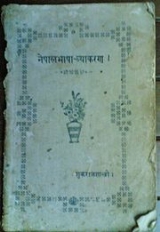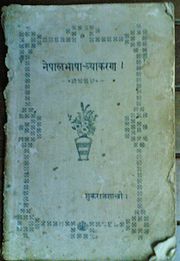
Nepal Bhasa renaissance
Encyclopedia
Nepal Bhasa renaissance was the movement to revive and modernize the Nepal Bhasa
language during the period 1908 to 1940. The movement was spontaneous and not orchestrated. However, the sum total of activities conducted during this era had a profound impact on the overall course of the language development.
Nishthananda, Siddhidas, Jagatsundar and Yogbir Singh are considered as the four pillars of Nepal Bhasa.
 Sukraraj Shastri published the first grammar book in Nepal Bhasa (in N.S.
Sukraraj Shastri published the first grammar book in Nepal Bhasa (in N.S.
1048, Kaulaathwa 10) called "Nepalbhasa byakaran". Before that, grammar was limited to manuscripts and traditional teachings with wide variability. This publication initiated a standardization of grammar. Publication of Nepal Bhasa reader aided in further standardization of vocabulary.
The publication of dictionary and English-Nepal Bhasa translation by Jagat Sundar Malla helped in standardization of vocabulary.
was introduced into Nepal Bhasa during this era. Modern prose and poetry were established and epic writing were firmly reestablished during this era.
(N.S.
987-N.S.1050) read as follows
which state that even a moron can improve with the company of good people just like even a drop of water appears like a pearl when it descends upon the leaves of a lotus plant.
Nepal Bhasa
Nepal Bhasa is one of the major languages of Nepal, and is also spoken in India, particularly in Sikkim where it is one of the 11 official languages. Nepal Bhasa is the mother tongue of about 3% of the people in Nepal . It is spoken mainly by the Newars, who chiefly inhabit the towns of the...
language during the period 1908 to 1940. The movement was spontaneous and not orchestrated. However, the sum total of activities conducted during this era had a profound impact on the overall course of the language development.
Factors and influences
Many factors played impact in Nepal Bhasa renaissance. Some of them are- Repression of Nepal Bhasa and its banning from official use by Rana regime
- The first generation of Nepalese scholars, who received modern education, attempted to modernize language
- Hindu and Buddhist literary movements in India and Nepal
- Regional language movement of Bengal
Renaissance figures
The most prominent people of this era were- Pandit Nisthananda Bajracharya
- Siddhidas MahajuSiddhidas MahajuSiddhidas Mahaju is one of the greatest writers in Nepal Bhasa literature. He is considered as the greatest poet in the language. He translated Ramayana to Nepal Bhasa. He is one of the four main people involved in Nepal Bhasa renaissance.-Influences:He influenced every single poet and writer...
- Jagat Sundar Malla
- Yogbir Singh Kansakar
- Shukraraj Shastri
- Dharmaditya Dharmacharya
Nishthananda, Siddhidas, Jagatsundar and Yogbir Singh are considered as the four pillars of Nepal Bhasa.
Publication
Nisthananda Bajracharya authored and printed the first printed book in Nepal Bhasa called Ek Binshati Pragyaparmita in 1909. He bought printing type from Kolkata, did the type-setting, proof-reading and printing himself.Standardization of Grammar

Nepal Sambat
Nepal Sambat is the national lunar calendar of Nepal. It was used throughout Medieval Nepal, and into early modern Nepal, until Chandra Sumsher decided to remove it in BS 1960. It was started in 880 AD during the reign of King Raghav Dev to commemorate the payment of all the debts of Nepalese...
1048, Kaulaathwa 10) called "Nepalbhasa byakaran". Before that, grammar was limited to manuscripts and traditional teachings with wide variability. This publication initiated a standardization of grammar. Publication of Nepal Bhasa reader aided in further standardization of vocabulary.
The publication of dictionary and English-Nepal Bhasa translation by Jagat Sundar Malla helped in standardization of vocabulary.
Translation
To increase the literary treasure of the language, translations of various literature was initiated in this era. Some of them are as follows- Lalitvistara, a Sanskrit Buddhist text was translated by Nisthananda Bajracharya, one of the four pillars of Nepal Bhasa during this era.
- Hindu epic Ramayan by Siddhidas Mahaju,
- Aesop's fablesAesop's FablesAesop's Fables or the Aesopica are a collection of fables credited to Aesop, a slave and story-teller believed to have lived in ancient Greece between 620 and 560 BCE. The fables remain a popular choice for moral education of children today...
by Jagat Sundar Malla
Education
Jagat Sundar Malla was a pioneer of modern education. He turned his own house into a free school. To overcome the lack of teaching materials, he wrote many course books himself, including an English-Nepal Bhasa-English dictionary and translated Aesop's Fables in 1915 into Nepal Bhasa. Poet Yogbir Singh Kansakar stressed female education.Research
Scientific research on the language began in this period. It was identified that Nepal Bhasa is a Sino-Tibetan language and not an Indo-Aryan language (as was believed) in this era. Various ancient manuscripts were collected and researched during this era.Literature
Modern literatureModern literature
Modern literature can either refer to*modernist literature *modern literature ....
was introduced into Nepal Bhasa during this era. Modern prose and poetry were established and epic writing were firmly reestablished during this era.
Activism and identity
Renaissance marked the revival of the term "Nepal Bhasa" to name the language rather than the Khas imposed term "Newari". Figures like Dhammaditya Dhammacharya were active and conscious about the proper nomenclature of the language.Literary samples
Some of the lines from Sajjan Hridayabharan of Siddhidas MahajuSiddhidas Mahaju
Siddhidas Mahaju is one of the greatest writers in Nepal Bhasa literature. He is considered as the greatest poet in the language. He translated Ramayana to Nepal Bhasa. He is one of the four main people involved in Nepal Bhasa renaissance.-Influences:He influenced every single poet and writer...
(N.S.
Nepal Sambat
Nepal Sambat is the national lunar calendar of Nepal. It was used throughout Medieval Nepal, and into early modern Nepal, until Chandra Sumsher decided to remove it in BS 1960. It was started in 880 AD during the reign of King Raghav Dev to commemorate the payment of all the debts of Nepalese...
987-N.S.1050) read as follows
- सज्जन मनुष्या संगतनं मूर्ख नापं भिना वै
- पलेला लपते ल वंसा म्वति थें ल सना वै
which state that even a moron can improve with the company of good people just like even a drop of water appears like a pearl when it descends upon the leaves of a lotus plant.
Impact
Much of the literary activities conducted in modern era were a propagation of the activities initiated in this era. The era created a new breed of modern writers. Unlike medieval era or dark era writers, these writers were commoners and not aristocrats. Hence, literature reached the grass-roots level of society. Some of the most prominent impacts of the activities of this era are- Epic Sugata Saurabha by Chittadhar Hridaya is the greatest epic written in the language along the lines of Nisthananda Bajracharya
- Nepal Bhasa movementNepal Bhasa movementNepal Bhasa movement is a linguistic movement of Nepal. It aims at the recognition and usage of Nepal Bhasa along with other Nepalese languages for official purposes.-History:...
which helped establish Nepal Bhasa as a national language of Nepal after 2006 democratic movement were along the line of the movement of Dhammaditya Dhammacharya

